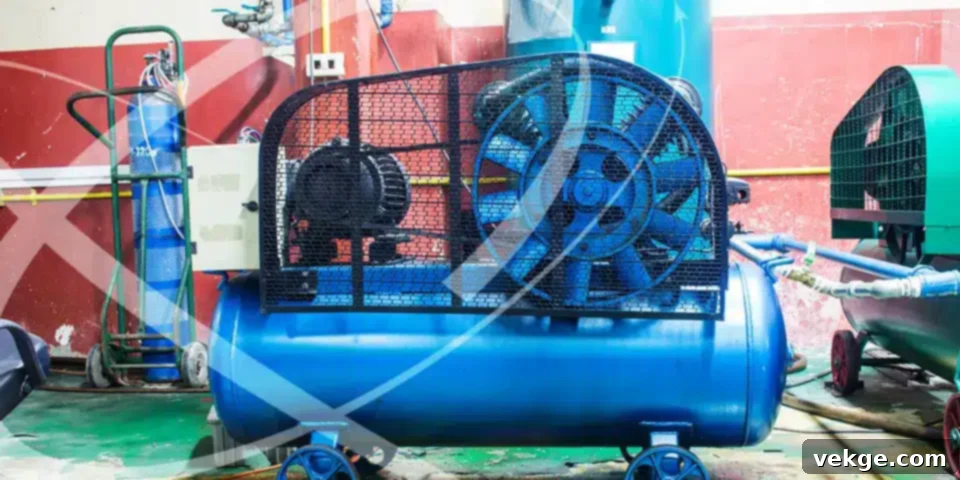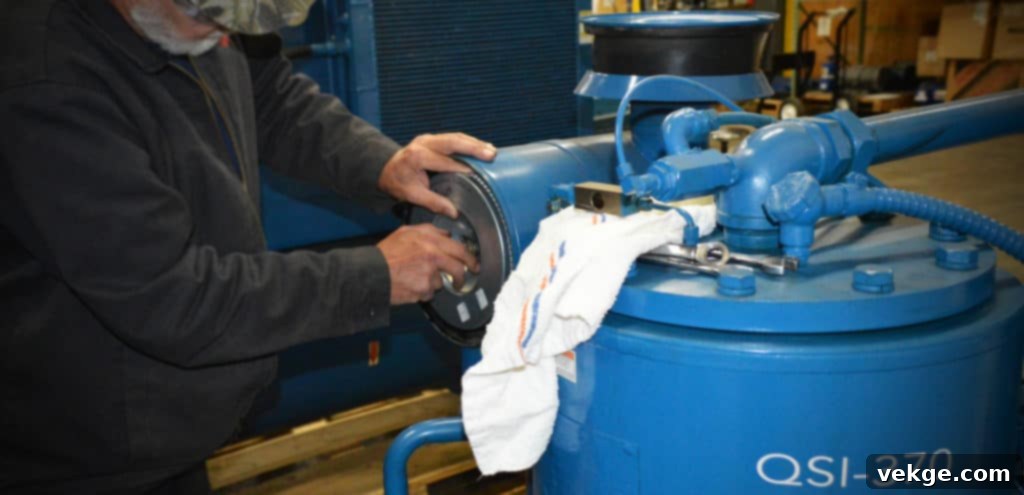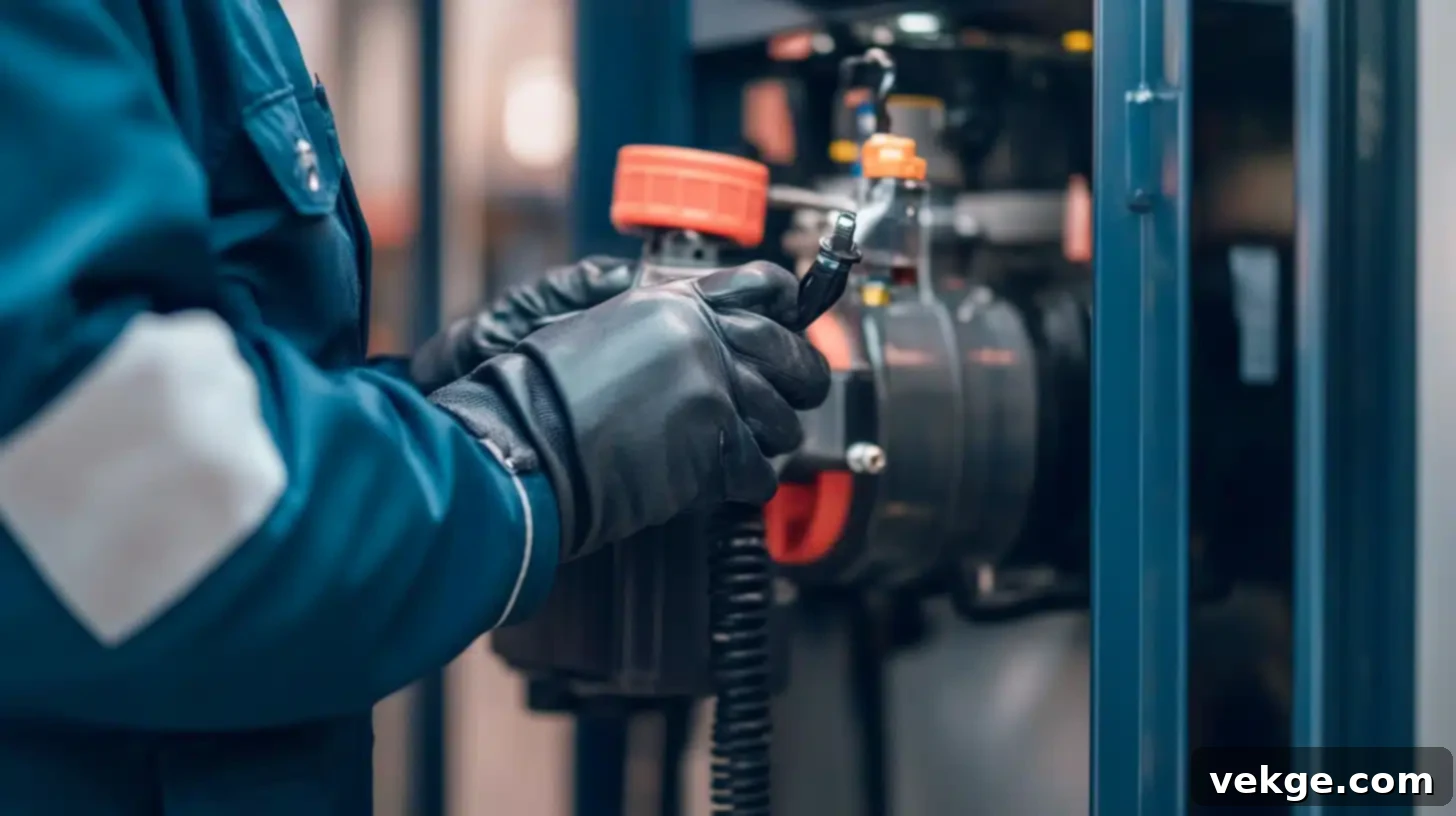Mastering Gas-Powered Air Compressor Maintenance: Your Ultimate Guide to Longevity and Peak Performance
Gas-powered air compressors are indispensable tools for both professional tradespeople and dedicated DIY enthusiasts. Their robust performance, impressive portability, and the ability to operate independently of an electrical power source make them ideal for a wide array of applications, from powering heavy-duty pneumatic tools on construction sites to quickly inflating tires in remote locations. However, like any complex machinery featuring an internal combustion engine and intricate mechanical components, these powerful devices demand consistent attention and proper maintenance. Neglecting their upkeep can lead to diminished performance, costly repairs, and a significantly shortened operational lifespan. This comprehensive guide will walk you through the essential maintenance practices to keep your gas-powered air compressor running at its absolute best for years to come.
The Foundation: Regular Inspections Before Every Use

One of the most critical and often overlooked aspects of maintaining your gas-powered air compressor is establishing a routine of regular, thorough inspections. Before each use, taking a few moments to visually examine your equipment can prevent minor issues from escalating into major problems. This preventative approach not only safeguards your investment but also ensures a safer working environment.
Visual Checks for Wear and Tear
Begin by carefully inspecting the entire unit for any visible signs of wear, damage, or loose components. Pay close attention to the following areas:
- Hoses and Lines: Examine all air hoses, fuel lines, and any other visible tubing for cracks, kinks, abrasions, or leaks. Ensure all connections and fittings are tight and secure. A leaking air hose can significantly reduce compressor efficiency, while a leaking fuel line poses a fire hazard.
- Belts (if applicable): For belt-driven compressors, check the drive belt for fraying, cracks, or excessive looseness/tightness. A worn belt can slip, leading to power loss, while an overly tight belt can strain bearings.
- Fittings and Fasteners: Ensure all nuts, bolts, and other fasteners are snug. Vibrations during operation can cause them to loosen over time.
- Tank Condition: Look for any dents, rust, or other damage on the air receiver tank. While minor cosmetic damage might not be critical, any significant compromise to the tank’s integrity warrants immediate professional inspection.
- Gauges and Controls: Verify that all pressure gauges are functioning correctly and that control switches and valves move freely without sticking.
Essential Fluid and Filter Checks
Beyond structural integrity, your compressor’s operational fluids and filters require attention:
- Oil Level: Check the engine oil level using the dipstick. Ensure it’s within the recommended range. Low oil levels can lead to severe engine damage.
- Fuel Level: Confirm you have sufficient fuel for the task at hand. Avoid running the tank completely dry, as this can sometimes introduce air into the fuel lines, making restarting difficult.
- Air Filter: Give the air filter a quick visual check for excessive dirt or blockages. A clogged air filter restricts airflow, forcing the engine and pump to work harder.
By making these simple checks a habit before you start your compressor, you significantly reduce the risk of accidents during operation and contribute immensely to extending the overall life cycle of your valuable equipment.
The Lifeblood: Oil Changes and Lubrication
Just as oil is crucial for a car’s engine, it’s the primary and most vital component in maintaining a gas power air compressor. The oil serves multiple critical functions within both the engine and the compressor pump, ensuring smooth operation and preventing premature wear.
Why Oil Matters for Your Compressor
The oil in your compressor performs several essential tasks:
- Lubrication: It coats all moving parts, reducing friction between metal surfaces. Without adequate lubrication, components would grind against each other, generating immense heat and rapidly leading to wear and seizure.
- Cooling: As parts move, they generate heat. Oil helps dissipate this heat away from critical components, preventing overheating.
- Sealing: In the compressor pump, oil helps create a seal between the piston rings and cylinder walls, maintaining compression efficiency.
- Cleaning: Oil circulates throughout the system, picking up tiny metal particles and other contaminants, holding them in suspension until they are removed during an oil change or filtered out.
Choosing the Right Oil
Always refer to your manufacturer’s recommendations for the appropriate type and viscosity of oil. Gas-powered air compressors typically use specific types of oil, often either conventional or synthetic compressor oils, depending on the model and its operating conditions. Using the wrong oil can compromise performance and longevity. Factors like operating temperature and environment might also influence the recommended oil type.
Oil Change Intervals and Procedure
The most crucial part of oil maintenance is adhering to the recommended oil change interval. This is generally every 50 to 100 operating hours, but always consult your compressor’s owner’s manual for precise specifications. Operating your compressor beyond these intervals with degraded or contaminated oil can lead to significant and expensive damage to both the engine and the compressor pump.
When changing the oil:
- Run the compressor for a few minutes to warm the oil, which helps it drain more thoroughly.
- Turn off the engine and remove the spark plug wire for safety.
- Place a suitable drain pan beneath the oil drain plug.
- Carefully remove the drain plug and allow all the old oil to drain completely.
- Replace the drain plug securely.
- If your compressor has an oil filter, replace it at this time according to the manufacturer’s instructions.
- Refill the crankcase with the recommended amount and type of new oil, using a funnel to avoid spills.
- Check the dipstick to ensure the oil level is within the safe operating range.
Diligence with oil changes is arguably the single most impactful maintenance task for extending the life and ensuring the consistent, efficient operation of your gas-powered air compressor.
Breathing Easy: Air Filter Maintenance

The air filter is a humble but incredibly critical component that plays a vital role in maintaining the efficiency and longevity of both your compressor’s engine and its pump. It acts as the first line of defense against harmful airborne particles, protecting the internal workings from abrasive damage.
The Role of a Clean Air Filter
A clean air filter ensures that only clean air enters the engine for combustion and the compressor pump for compression. This prevents:
- Engine Wear: Dust and grit can cause premature wear on piston rings, cylinder walls, and other critical engine components.
- Reduced Performance: A dirty or clogged filter restricts airflow, forcing the engine to work harder to draw in air. This leads to reduced power output, decreased compression efficiency, and increased fuel consumption.
- Overheating: An engine struggling to breathe can run hotter than normal, contributing to overheating.
Inspection and Maintenance Schedule
Depending on your usage and the environment, you should clean or replace the air filter regularly. For most compressors, this may mean checking the filter every 25 hours of operation. However, if you’re using the compressor in particularly dusty, dirty, or sandy environments (such as construction sites or workshops with significant sawdust), you might need to inspect and service it much more frequently, potentially even daily.
To inspect your air filter, simply remove it from its housing and hold it up to a light source. If you can’t see light passing through, or if it appears heavily soiled, it’s time for service. Some filters can be cleaned (e.g., tapped gently, blown with low-pressure compressed air from the inside out, or washed if specified by the manufacturer), while others are designed for replacement only. Always refer to your owner’s manual for the correct procedure. A clean filter ensures that the compressor operates efficiently, maintains its power output, and can help prevent costly engine and pump repairs down the line.
Preventing Corrosion: Regular Tank Draining
One of the most common and easily preventable problems associated with air compressors is the accumulation of moisture inside the air receiver tank. This issue is particularly prevalent when compressors are operated in humid settings or experience significant temperature fluctuations.
The Problem of Moisture Build-up
As ambient air is drawn into the compressor and compressed, its temperature rises. When this hot, compressed air then enters the tank, it cools down. This cooling process causes water vapor in the air to condense back into liquid water, which then collects at the bottom of the tank. If this condensate is not regularly drained, it leads to several significant problems:
- Rust and Corrosion: The presence of standing water, especially in a metal tank, inevitably leads to rust and corrosion. Over time, this can weaken the tank walls, potentially leading to leaks or, in extreme cases, a dangerous tank rupture.
- Contaminated Air Supply: The collected water can be pushed out into your air lines, contaminating your pneumatic tools or the surfaces you’re painting or cleaning. This can lead to tool damage, poor finishes, and overall inefficiency.
- Reduced Tank Capacity: Accumulated water takes up valuable space, reducing the effective air storage capacity of your tank and causing the compressor to cycle more frequently.
The Draining Process and Frequency
Gas-powered air compressors commonly feature a drain valve (often a petcock or ball valve) located at the very bottom of the air receiver tank. To drain the tank:
- Ensure the compressor is turned off and depressurized.
- Position a suitable container (like a bucket) beneath the drain valve to catch the water and any oil residue.
- Carefully open the drain valve. You will hear air escaping, followed by water.
- Allow all the water to drain completely until only air escapes.
- Close the drain valve tightly.
Make it a habit to drain the tank every time you use the compressor, or at least once a week if you operate the compressor on a regular basis. In highly humid environments or with heavy usage, daily draining might be necessary. This one simple, quick step is paramount to ensuring a long and safe life for your compressor’s tank and helps ensure that it is running as efficiently as possible with clean, dry air.
Powering Up: Fuel System and Engine Component Checks
Since gas-powered air compressors rely on internal combustion engines, the health of their fuel system and key engine components is absolutely critical for reliable starting and consistent performance.
Fuel Quality and Management
- Proper Fuel Type: Always fill your tank with the fuel type and octane rating specified in the manufacturer’s manual. Using incorrect fuel can damage the engine.
- Fresh Fuel: Old or stale fuel is a common cause of starting issues and poor engine performance. Gasoline degrades over time, especially with ethanol blends, which can absorb moisture and separate. If your compressor has been sitting idle for more than a few weeks, it’s often best to drain the old fuel and add fresh, treated fuel.
- Fuel Stabilizer: For any period of storage longer than a month, it’s highly recommended to add a high-quality fuel stabilizer to the gasoline. This prevents fuel degradation and keeps the fuel system clean. Run the engine briefly after adding stabilizer to ensure it circulates throughout the fuel system.
Inspecting Fuel Lines and Filters
Regularly check the fuel lines for any signs of leaks, cracks, brittleness, or kinks. Replace any damaged parts immediately. Most gas engines also have an inline fuel filter; inspect this filter and replace it periodically according to your owner’s manual. A clogged fuel filter can starve the engine of fuel, leading to sputtering, loss of power, or failure to start.
Spark Plug Maintenance
The spark plug is essential for igniting the fuel-air mixture in the engine’s cylinder. A fouled or worn spark plug can cause difficult starting, misfires, reduced power, and increased fuel consumption. Annually, or according to your manual’s recommendations:
- Remove the spark plug (always use the correct wrench or socket).
- Inspect the electrode for signs of wear, fouling (carbon buildup), or oil deposits.
- Clean any minor deposits with a wire brush or replace the plug if it’s heavily fouled or worn.
- Check the spark plug gap using a feeler gauge and adjust it to the manufacturer’s specification.
- Reinstall the spark plug, tightening it to the correct torque.
By diligently checking these fuel system and ignition components, you ensure your compressor’s engine starts easily and runs reliably, providing consistent power for your pneumatic tasks.
Beyond the Basics: Advanced Maintenance and Safety
Belt Tension and Condition (for Belt-Driven Models)
If your gas-powered air compressor is a belt-driven model, proper belt maintenance is crucial. Regularly inspect the drive belt for signs of wear such as cracks, fraying, or glazing. Also, check for correct tension. A belt that is too loose will slip, causing loss of power and generating heat, while a belt that is too tight can put excessive strain on motor and pump bearings, leading to premature failure. Adjust the belt tension according to your compressor’s manual, typically allowing for a small amount of deflection when pressed.
Safety Valve Verification
The pressure relief valve, often called the safety valve, is a critical safety device designed to open and release excess pressure if the compressor’s main pressure switch fails. It is a non-negotiable component that must be in perfect working order. Test the safety valve gently once a month by pulling the ring briefly to ensure it actuates freely and is not seized. A small burst of air should escape. Never operate a compressor with a faulty or suspect safety valve; replace it immediately if there’s any doubt about its function. This simple check is paramount for preventing dangerous over-pressurization.
Cleaning and General Upkeep
While often overlooked, keeping the exterior of your gas-powered air compressor clean is also a form of preventative maintenance. Regularly wipe down the machine to remove dirt, dust, oil, and debris. A clean compressor:
- Allows for easier inspection of components.
- Prevents the buildup of insulating layers that can lead to overheating.
- Reduces the risk of contamination entering critical systems.
- Maintains the overall appearance and protects painted surfaces from corrosion.
Protecting Your Investment: Proper Storage Techniques
How you store your gas-powered air compressor when it’s not in use significantly impacts its long-term health and readiness for the next task. Proper storage prevents degradation and damage from environmental factors.
Short-Term Storage (Days to Weeks)
For short periods of inactivity:
- Clean Exterior: Give the compressor a quick wipe-down.
- Drain Tank: Always drain any condensation from the air receiver tank.
- Store Appropriately: Keep the compressor in a clean, dry place, away from direct sunlight, excessive moisture, and extreme temperatures.
Long-Term Storage (Months)
If you plan to store your gas-powered air compressor for an extended period, more thorough preparation is necessary:
- Fuel Management: Either drain the fuel tank completely or add a high-quality fuel stabilizer and run the engine for a few minutes to ensure the stabilized fuel circulates through the carburetor. Draining is often preferred to completely eliminate issues with stale fuel.
- Oil Change: Perform an oil change, refilling with fresh, clean oil. This ensures that any contaminants in the old oil are removed before prolonged storage.
- Engine Fogging: For internal combustion engines, removing the spark plug and spraying a small amount of engine fogging oil into the cylinder can protect the cylinder walls and piston rings from rust during storage. Turn the engine over slowly a few times by hand (with the spark plug out) to distribute the oil, then replace the plug.
- Air Filter: Clean or replace the air filter to prevent dust accumulation.
- Drain Air Tank: Ensure the air tank is completely drained of all air and moisture. Leave the drain valve slightly open to allow for air circulation and prevent moisture buildup.
- Cover and Protect: Cover the compressor with a breathable cover to protect it from dust, debris, and potential pests. Avoid non-breathable covers that can trap moisture.
- Location: Store the compressor in a climate-controlled environment if possible, or at least in a dry, sheltered area free from extreme temperature fluctuations.
Diligently following these storage practices will prevent many common issues associated with disuse, such as rust, fuel system blockages, and degraded fluids, ensuring your compressor is ready to go when you need it next.
Conclusion
In summary, gas-powered air compressors are invaluable assets that require a commitment to regular, thorough maintenance to continue operating efficiently and effectively. This isn’t merely about extending their lifespan; it’s about ensuring reliability, maintaining peak performance, and guaranteeing safe operation for every task. By making routine inspections, timely oil changes, diligent air filter maintenance, consistent tank draining, careful fuel system checks, and proper storage a consistent part of your routine, you are making a wise investment in your tool’s future.
These preventative measures might seem like an extra step, but the small amount of time and effort expended annually or periodically will pay off exponentially in terms of avoiding costly repairs, preventing frustrating breakdowns, and preserving the powerful capabilities of your equipment. With a little thought and care, your gas-powered air compressor will always be in tip-top shape, ready to tackle any job you throw its way, ensuring productivity and peace of mind for years to come.
